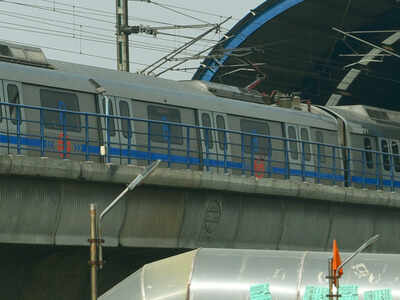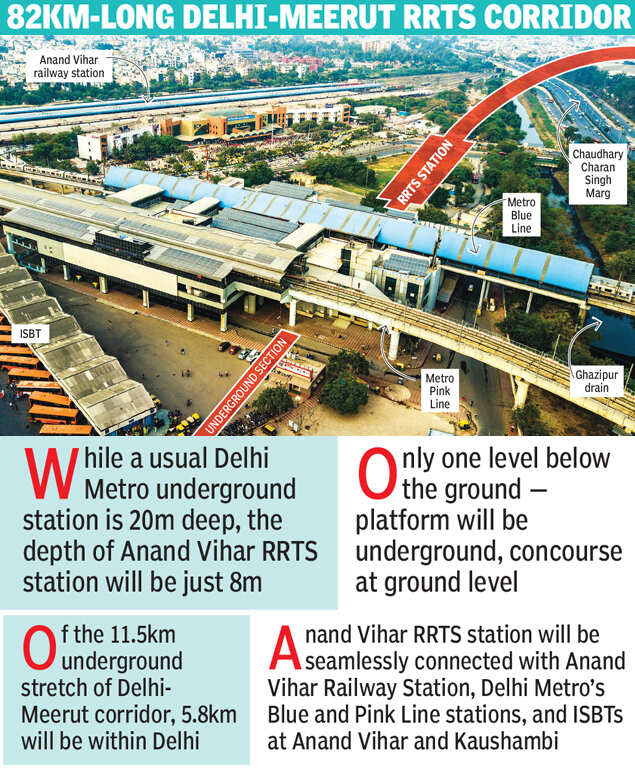
NEW DELHI: Anand Vihar in east Delhi is one of the city’s biggest transport hubs with the presence of a railway station, two Delhi Metro corridors and two inter-state bus terminals on either side of the Delhi-Uttar Pradesh border. A new addition to the hub is going to be the underground Anand Vihar station of the 82-km long Delhi-Meerut Regional Rapid Transit System (RRTS) corridor, which will also seamlessly integrate these different modes of transport.
The National Capital Region Transport Corporation (NCRTC), which is building India’s first RRTS corridor, said a key aspect of the planning was the integration of its stations with other modes of transport such as metro train network, bus terminals, airports and Indian Railways through walkways, lifts, escalators, foot bridges and underpasses.

An NCRTC spokesperson said, “Anand Vihar is one of the busiest public spaces linked by several modes of public transport. Lakhs of people, among them senior citizens and children, use these transport modes daily, often with heavy luggage. The lack of adequate integration leads to unsafe road crossing and numerous level changes, making the journey unsafe, time consuming and inconvenient, and ultimately forces people to shift to private vehicles.”
Of the 22 RRTS stations on the Delhi-Meerut corridor, four are underground, with just the Anand Vihar station among the four in the Delhi stretch of the corridor. The underground station will have some unique features, according to NCRTC. “Only one level will be below the ground,” the spokesperson disclosed. “The platform will be underground but the concourse will be at the ground level.”
He pointed out that a typical underground Delhi Metro station was constructed two levels under the ground, with the platform usually located at a depth of 20 metres. In the case of Anand Vihar RRTS station, however, the station will be located just eight metres below ground, and the cut-and-cover method will be employed to construct it.
“The construction of this station will be technologically complex as RRTS trains will pass underneath the Delhi metro Blue Line (Dwarka-Vaishali),” the spokesperson said. But he also said that the station design would allow safe, convenient and faster movement of commuters from Anand Vihar RRTS station to the public transport modes and vice-versa. The spokesperson claimed, “Such a design is not only commuter-centric, but will significantly reduce the construction cost of the station.”
The idea is that the station design will allow commuters to avoid having to step on the roads while moving from one mode of transport to another. This will be a comparatively safer, more comfortable and hassle-free travel experience for commuters.
The spokesperson also said, “Around 11.5 km of the Delhi-Meerut corridor will be underground, of which 5.8 km from the elevated New Ashok Nagar RRTS station to BEL, Ghaziabad, will be in Delhi,” he said. NCRTC has floated the tender for the design and excavation of underground passages by tunnel boring machines in the Delhi segment.
The National Capital Region Transport Corporation (NCRTC), which is building India’s first RRTS corridor, said a key aspect of the planning was the integration of its stations with other modes of transport such as metro train network, bus terminals, airports and Indian Railways through walkways, lifts, escalators, foot bridges and underpasses.

An NCRTC spokesperson said, “Anand Vihar is one of the busiest public spaces linked by several modes of public transport. Lakhs of people, among them senior citizens and children, use these transport modes daily, often with heavy luggage. The lack of adequate integration leads to unsafe road crossing and numerous level changes, making the journey unsafe, time consuming and inconvenient, and ultimately forces people to shift to private vehicles.”
Of the 22 RRTS stations on the Delhi-Meerut corridor, four are underground, with just the Anand Vihar station among the four in the Delhi stretch of the corridor. The underground station will have some unique features, according to NCRTC. “Only one level will be below the ground,” the spokesperson disclosed. “The platform will be underground but the concourse will be at the ground level.”
He pointed out that a typical underground Delhi Metro station was constructed two levels under the ground, with the platform usually located at a depth of 20 metres. In the case of Anand Vihar RRTS station, however, the station will be located just eight metres below ground, and the cut-and-cover method will be employed to construct it.
“The construction of this station will be technologically complex as RRTS trains will pass underneath the Delhi metro Blue Line (Dwarka-Vaishali),” the spokesperson said. But he also said that the station design would allow safe, convenient and faster movement of commuters from Anand Vihar RRTS station to the public transport modes and vice-versa. The spokesperson claimed, “Such a design is not only commuter-centric, but will significantly reduce the construction cost of the station.”
The idea is that the station design will allow commuters to avoid having to step on the roads while moving from one mode of transport to another. This will be a comparatively safer, more comfortable and hassle-free travel experience for commuters.
The spokesperson also said, “Around 11.5 km of the Delhi-Meerut corridor will be underground, of which 5.8 km from the elevated New Ashok Nagar RRTS station to BEL, Ghaziabad, will be in Delhi,” he said. NCRTC has floated the tender for the design and excavation of underground passages by tunnel boring machines in the Delhi segment.
Trending Topics
LATEST VIDEOS
City
 AAP set to retain Delhi, third term for Kejriwal, predict exit polls unanimously
AAP set to retain Delhi, third term for Kejriwal, predict exit polls unanimously  Delhi CM Arvind Kejriwal hits out at Smriti Irani, says women decide their family vote
Delhi CM Arvind Kejriwal hits out at Smriti Irani, says women decide their family vote  Three-storey building collapses in Punjab's Mohali, several feared trapped
Three-storey building collapses in Punjab's Mohali, several feared trapped  I thank police for arresting AAP worker who used abusive language against me: Alka Lamba
I thank police for arresting AAP worker who used abusive language against me: Alka Lamba
More from TOI
Navbharat Times
Featured Today in Travel
Get the app





